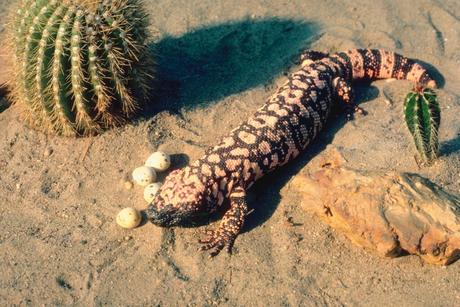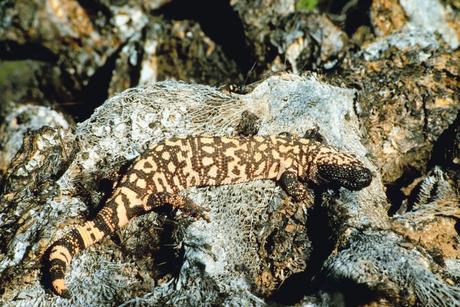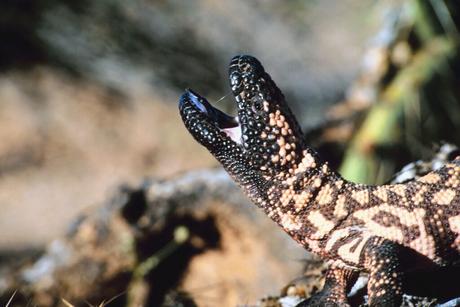These heavy bodied lizards are found in the southwestern United States and northwestern Mexico, primarily in desert and semi-arid regions.
Their range covers a large area. It stretches from southern Nevada and southwestern Utah through Arizona and New Mexico. It extends even further into parts of Sonora and Chihuahua in Mexico.
Gila monsters have survived and flourished despite having a limited range. They have done so in some of the world's harshest and most unforgiving environments.
They have adapted to extreme heat and drought. This adaptation includes unique hunting and defense mechanisms. These skills help them survive in a tough environment where resources are scarce and predators are plentiful.
They prefer rocky areas with crevices and burrows for shelter and are frequently found in areas with a high concentration of their preferred prey, such as small mammals and birds.
In addition to their preferred prey, Gila monsters are also known to eat eggs, insects, and other reptiles. They are ambush predators, meaning they wait for their prey to come to them rather than actively seeking it out.
Once they have captured their prey, they use their powerful jaws to deliver a venomous bite that helps immobilize and kill their victim.
This venom is also used as a defense mechanism against predators, as they are typically slow-moving and rely on their venom to protect themselves from potential threats.
Despite their venomous reputation, Gila monsters are not aggressive towards humans and will typically only bite if provoked or handled improperly. It is important to give these creatures their space and observe them from a safe distance in their natural habitat.
How Does The Gila Monster Survive In A Desert Habitat?
By adapting to their environment, the Gila Monster has developed several unique characteristics that help them survive in their harsh desert habitat. They have the ability to store fat in their tails, which allows them to go long periods without food.
They also have the ability to conserve water by excreting a concentrated form of urine, and they are able to regulate their body temperature by burrowing underground or seeking shade during the hottest parts of the day.
Gila monster's spend only a fraction of its day actively hunting or moving around; the rest of the time is spent basking in the sun to raise its core temperature and conserve energy.
Overall, the Gila Monster's ability to adapt to their environment has allowed them to thrive in their desert habitat and survive the harsh conditions they face.
Feeding Habits of Gila Monsters

Carnivorous by nature, Gila monsters derive the majority of their nutrition from the eggs of birds and small mammals, as well as birds and other small mammals.
They have a distinct way of feeding. They will bite and hold onto their prey for as long as 15 minutes. This allows their venom to gradually render their prey helpless. The Gila monster's venom is not lethal to humans but can cause pain and swelling.
Dead animals are also a common food source for them, and they have been observed eating insects and even other reptiles on occasion. Their feeding habits play an important role in the ecosystem, assisting in the control of small mammal and bird populations.
It has been discovered that Gila monsters can store enough fat in their tails to last for months without eating. In the desert, where food is often scarce, this adaptation is especially helpful. They have the ability to go for extended periods of time without eating. However, they are opportunistic eaters and will consume food whenever it is available.
Because of their slow metabolisms, Gila monsters don't need as much food as other animals their size. They can also save water by excreting concentrated urine and storing it in their bodies. This enables them to survive in their arid environment. Their slow metabolism has an impact on their reproductive rate. Females lay only one clutch of eggs each year.
Overall, Gila monsters are fascinating creatures with unique adaptations that allow them to thrive.
The Life Cycle Of Gila Monsters

Gila monsters have a unique life cycle that begins with mating, which usually occurs in the spring. Males compete for female attention during this time. They do this by engaging in aggressive behavior and displaying their brightly colored bellies.
Once a female has chosen a mate, she will lay a clutch of eggs in a burrow or other protected area. The eggs will then incubate for several months, with the hatchlings emerging in the late summer or early fall.
Gila monsters are unique in that they show parental care. Females guard their eggs and hatchlings until they are able to survive independently. This behavior is rarely seen in other lizard species.
After hatching, the young Gila monsters are only a few inches long and are quite vulnerable to predators. However, they possess venom from birth, which they use to defend themselves against potential threats.
The juveniles will spend the first few years of their lives underground, feeding on insects and small rodents. As they grow larger and stronger, they will venture out in search of larger prey, such as birds and mammals.
Gila monsters can live up to 20-30 years in the wild, although their lifespan can be longer in captivity.
The life cycle and behavior of Gila monsters provide an interesting insight. It shows us the adaptations and strategies that desert-dwelling animals use to survive.
The Importance Of Conservation Efforts For Gila Monsters

Conservation efforts for Gila Monsters are crucial to ensure their survival and maintain a healthy ecosystem. Habitat destruction, illegal collection for the pet trade, and persecution by humans are some of the threats they face.
It is important to protect their natural habitat, regulate the pet trade, and educate the public about the importance of these unique reptiles. By doing so, we can help preserve the Gila monster population and maintain a balanced ecosystem.
In addition to the threats mentioned above, climate change is also a concern for Gila Monsters. As temperatures rise, their habitat may become unsuitable, forcing them to move to new areas or face extinction.
Conservation efforts must take into account the potential effects of climate change and work towards mitigating their impact.
In recent years, conservation organizations and government agencies have taken steps to protect Gila Monsters, including listing them as a protected species and implementing habitat restoration projects.
In 1952, the Gila monster became the first venomous lizard in the United States to have legal protection. However, more work needs to be done to ensure their long-term survival.
Through continued conservation efforts and public awareness, we can help protect these species and their habitats for future generations to enjoy and benefit from.
It is crucial that we take action now to prevent further decline and extinction of these important species.
